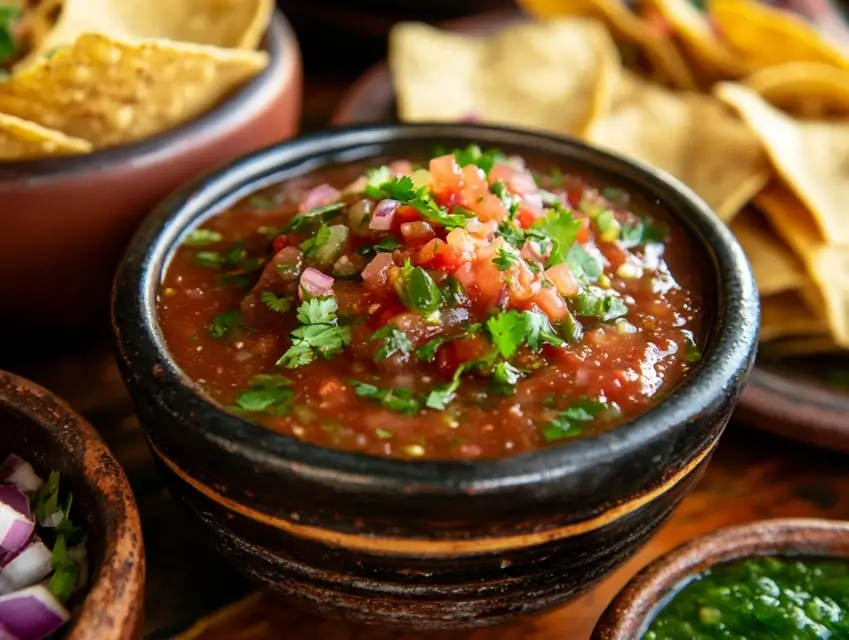The Different Types of Mexican Salsas and How They’re Made
Mexican cuisine is known for its bold flavors, and nothing defines it better than salsa. Whether mild, fiery, smoky, or tangy, salsa is an essential component of almost every dish. After years of tasting, making, and experimenting with different types of Mexican salsas, I’ve learned that each one has its own unique purpose, preparation method, and secret ingredients. This guide will explore the most iconic Mexican salsas, how they are made, and some of the best tips I’ve picked up along the way.

1. Salsa Roja – The Classic Red Salsa
Salsa roja is the most versatile salsa in Mexican cuisine. Found in restaurants and homes across Mexico, it’s a staple for tacos, grilled meats, eggs, and tortilla chips.
Ingredients and Preparation
- Tomatoes (fresh or roasted)
- Dried or fresh chilies (guajillo, chile de árbol, or chipotle)
- Onion
- Garlic
- Salt
- A touch of vinegar or lime juice for acidity
The method varies, but the most flavorful salsa roja is made by roasting the tomatoes, onions, and garlic on a dry comal until they are charred. Dried chilies should be toasted and soaked in warm water before blending everything together.
My First Experience Making Salsa Roja
The first time I made salsa roja, I blended raw tomatoes and chilies without roasting them. The result was decent, but it lacked depth. Later, I learned the traditional technique: roasting the ingredients and toasting the chilies before blending. The transformation was incredible. The salsa had a deep, smoky flavor, and the heat was perfectly balanced. From that moment, I never made it any other way.
2. Salsa Verde – The Tangy Green Salsa That Goes with Everything
Salsa verde is my personal favorite because of its bright and tangy flavor. Whether on tacos, enchiladas, tamales, or chilaquiles, it adds a refreshing contrast to rich dishes.
Ingredients and Preparation
- Tomatillos (boiled or roasted)
- Green chilies (serrano or jalapeño)
- Onion
- Garlic
- Fresh cilantro
- Lime juice or vinegar
Some versions use raw tomatillos for a fresh, acidic taste, while others roast them for a deeper flavor.
The Secret to a Perfect Salsa Verde
During a trip to Puebla, I had the best salsa verde I had ever tasted. When I asked the vendor for his secret, he explained that instead of roasting the tomatillos, he boiled them with a little onion and garlic, then blended in fresh cilantro at the end. He also added a small piece of avocado for a smoother texture. When I tried this method at home, the difference was undeniable—brighter, silkier, and perfectly balanced.
3. Salsa Taquera – The Spicy Taco Stand Salsa
Salsa taquera is a must-have at any street taco stand in Mexico. It’s a smooth, slightly oily, bright red salsa that delivers intense heat.
Ingredients and Preparation
- Chile de árbol (toasted)
- Garlic
- Vinegar
- Salt
- A small amount of oil for texture
The key is to toast the chile de árbol in a little oil before blending. This enhances the nutty, smoky flavors while maintaining the chili’s fiery heat.
My Spiciest Salsa Experience
While in Guadalajara, I tried a salsa taquera that was so spicy, I had to drink two glasses of horchata to recover. When I finally learned how to make my own, I followed the technique I had seen in taquerías—slowly toasting the chilies in oil before blending them with roasted garlic and a bit of vinegar. The result was a salsa that was just as fiery but perfectly balanced.
4. Salsa Macha – The Mexican Chili Oil That’s Addictive
Unlike traditional salsas, salsa macha is more like a chili oil. It’s made with dried chilies, nuts, and garlic fried in oil, giving it a rich, smoky, and slightly crunchy texture.
Ingredients and Preparation
- Dried chilies (morita, guajillo, or chile de árbol)
- Garlic
- Sesame seeds or peanuts
- Salt
- Oil (neutral-flavored like vegetable or peanut oil)
The chilies and garlic are fried slowly in oil, then blended with the nuts and a pinch of salt. Some variations include a splash of vinegar to balance the richness.
How I Fell in Love with Salsa Macha
I first encountered salsa macha in Veracruz, served with fresh seafood. It was nothing like the salsas I was used to. Instead of being a dip, it was a rich chili oil with a deep, smoky heat. When I made it at home, I discovered the key to the best salsa macha was frying the ingredients at a low temperature to avoid burning them. Once I perfected it, I started putting it on everything—tacos, eggs, and even pizza.
5. Pico de Gallo – The Fresh, Chunky Salsa That Brightens Any Dish
Unlike other salsas, pico de gallo is made with fresh, diced ingredients. It’s simple but adds brightness to any meal.
Ingredients and Preparation
- Ripe tomatoes (diced)
- Onion (finely chopped)
- Fresh cilantro
- Lime juice
- Jalapeño or serrano peppers
- Salt
The ingredients are mixed together and left to sit for at least 10 minutes so the flavors meld.
The Trick to a Perfect Pico de Gallo
I once had the best pico de gallo at a small beachside restaurant in Oaxaca. When I asked the cook why it tasted so much better than any I had made before, he shared his technique: letting the salsa rest before serving, using ripe tomatoes with the seeds removed to avoid excess water, and adding a small splash of orange juice to enhance the citrus notes. Ever since, I’ve made pico de gallo this way, and it always turns out perfect.
Final Thoughts: Why I Love Making Mexican Salsas
Making homemade Mexican salsas has been one of the most rewarding cooking experiences of my life. Each salsa has its own personality, and learning to make them has deepened my appreciation for Mexican cuisine.
- Salsa roja is smoky and versatile.
- Salsa verde is bright and tangy.
- Salsa taquera is bold and fiery.
- Salsa macha is rich and complex.
- Pico de gallo is fresh and vibrant.
Each time I make these salsas, I’m reminded of the incredible flavors of Mexico. Whether paired with tacos, grilled meats, or simple tortilla chips, there is always a salsa that can elevate the dish.
If you’ve never made these salsas at home, I highly recommend trying them. In Veracruz Restaurant we have the best offer salsas for you. Once you taste a homemade, properly made salsa, there’s no going back to store-bought versions.
